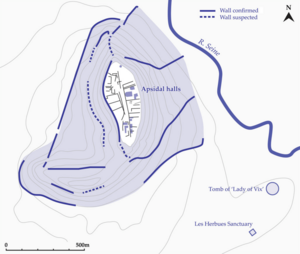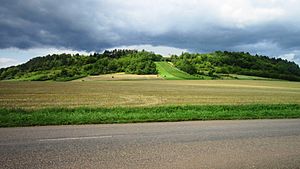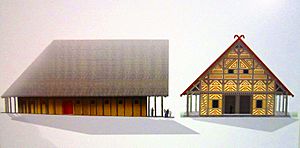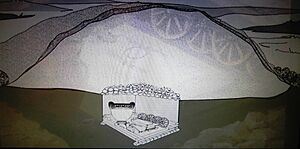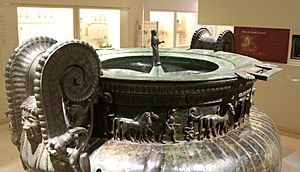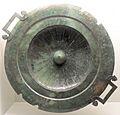Vix Grave facts for kids
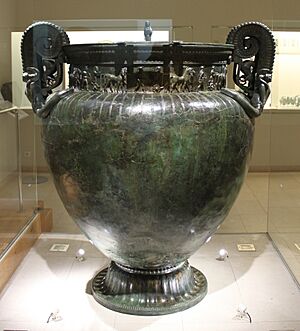
The Vix Grave is a very old burial mound found near the village of Vix in northern Burgundy, France. This whole area is a special prehistoric site from the Celtic times, around 2,500 years ago. It includes a strong settlement and several burial mounds.
One of these mounds held the grave of a powerful woman, often called the "Lady of Vix." Her grave, from about 500 BC, had never been touched. This meant it still held amazing treasures! These treasures, known as the Trésor de Vix in French, included beautiful jewelry and the famous "Vix krater." This krater is the largest metal pot ever found from ancient Western times. It stands tall at 1.63 meters (about 5 feet 4 inches).
Contents
Discovering the Vix Treasure
People started finding old items in the Vix area in April 1930. A local person who loved history first made these discoveries. Over the next few decades, more careful digs uncovered thousands of pottery pieces, brooches, jewelry, and other metal objects.
The most exciting find was the burial mound with the giant krater. This was dug up in early 1953 by a researcher named René Joffroy. Later, in 1991, new research began on Mont Lassois, led by Bruno Chaume. Since 2001, many universities have worked together to study Vix and its surroundings.
Where is Vix?
The Vix sites are close to the village of Vix. This is about 6 kilometers (4 miles) north of Châtillon-sur-Seine in the Côte-d'Or area of northeastern Burgundy. The main part of the site is Mont Lassois. This is a steep, flat-topped hill that stands out in the area. It was once a strong Celtic settlement, also known as an oppidum.
Southeast of the hill, there was a large burial ground. It covered 42 hectares (about 104 acres). Graves here ranged from the Late Bronze Age to the Late La Tène period. Other discoveries show that people lived and worked here even up to Late Antiquity.
During the 500s and 400s BC, the Vix settlement was very important for trade. It was located where the Seine River, a key water route, met a land route. This land route went from the Mediterranean Sea all the way to northern Europe. Also, Vix is in the middle of a rich farming area.
The Ancient Settlement on Mont Lassois
Strong Walls and Buildings
Digging at the top of Mont Lassois showed strong defenses. There were ditches and walls up to 8 meters (26 feet) thick. Inside these walls, archaeologists found many different buildings. These included houses made with posts, small pit dwellings, fireplaces, and storage areas built on stilts.
Special tools that look into the ground showed that the settlement was well-planned. It had a main street running north to south and different stages of buildings over time.
The "Palace" of the Lady of Vix
In 2006, an amazing building was found in the center of the site. It was a large complex with five big buildings. The main building was 35 by 22 meters (115 by 72 feet). Its roof was probably at least 15 meters (49 feet) high, like a modern church! This large hall had a rounded end and a front porch.
This main building looks a lot like the megaron buildings from early Greek architecture. Finding such a building in early Celtic Europe was very surprising. The discoveries suggest it was used for living or for big feasts. People have called this building the "Palace" of the Lady of Vix.
Another large building was found at the bottom of Mont Lassois, across the Seine River. It was similar in size and design to the palace on the hill. All six large buildings faced east, towards the sunrise. This might have been for symbolic reasons.
What Was Found at the Settlement?
Many items found at the Mont Lassois settlement show that people traded far and wide. They also show that Vix was an important economic center. The most common finds are pieces of pottery, with over 40,000 found so far. Many were made locally and had simple patterns or animal pictures.
Archaeologists also found imported Attic black figure vases from Greece. Many large pots and bowls came from Greek settlements in southern France. These pots were used to carry wine.
Jewelry found included brooches often decorated with amber or coral. There were also earrings, beads, slate bracelets, and rings. Some small bronze statues found probably came from the Mediterranean area. Not many weapons have been found, mostly projectiles and axes.
Mont Lassois had all the signs of an important settlement. It had strong walls, a main fort, a lower town, rare imported goods, and many rich burial mounds nearby.
The Burial Mounds
The Famous Vix Grave of 1953
The "Lady of Vix" was buried around 500 BC. Even though most of her body had disappeared over time, the items in the grave suggest she was a woman. She had lots of jewelry but no weapons. We don't know her exact social rank, but she was clearly very important. People have called her a "Queen," "Princess," or "Priestess of Vix." She was between 30 and 35 years old when she died.
The Burial and Her Treasures
Her burial was in a wooden room, 4 meters (13 feet) by 4 meters. This room was under a large mound of earth and stone. The mound was originally 42 meters (138 feet) wide and 5 meters (16 feet) high.
Her body was placed inside a cart or chariot. The wheels of the cart were taken off and put next to it. Only the metal parts of the cart survived. Her jewelry included a 24-carat gold torc or diadem that weighed 480 grams (over 1 pound). She also had a bronze torc, six brooches, six slate bracelets, and one bracelet made of amber beads.
The grave also held many items imported from Italy and Greece. All of these were used for preparing wine. These included the famous krater (see below), a silver phiale (a shallow bowl), an Etruscan bronze oinochoe (a wine jug), and several drinking cups. One cup was made around 525 BC. This helps us know when the grave was made. These items were likely placed on wooden tables that have since rotted away.
The Amazing Vix Krater
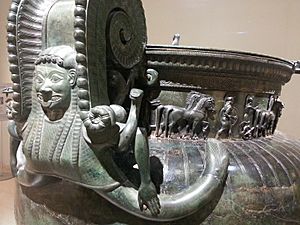
The biggest and most famous item from the grave is a beautifully decorated bronze volute krater. It is 1.63 meters (5 feet 4 inches) tall and weighs over 200 kilograms (450 pounds)! Kraters were pots used to mix wine and water. They were common in Greece and usually made of clay. The Vix krater is a symbol of how rich early Celtic burials were and how skilled ancient Greek bronze workers were.
- The krater was made of seven or more separate pieces. It had Greek letters on it, meaning it was probably brought to Burgundy in pieces and put together there.
- The main part of the vase was made from a single sheet of hammered bronze. It weighs about 60 kilograms (132 pounds). Its bottom is round, and it is 1.27 meters (4 feet 2 inches) wide. It could hold 1,100 liters (about 290 gallons) of liquid! Its walls are very thin, only about 1 millimeter thick. The krater was found crushed by the weight of the mound above it. It was carefully put back together after it was dug up.
- Its base is a single molded piece. It is 74 centimeters (29 inches) wide and weighs 20.2 kilograms (44.5 pounds). It held the round bottom of the main vase and kept it steady. It is decorated with plant designs.
- The three handles, supported by standing lionesses, each weighed about 46 kilograms (101 pounds). Each handle is 55 centimeters (22 inches) high and shaped like a spiral. Each is decorated with a scary gorgon face. This was a common design on Greek bronzes at the time.
- A band of hoplites (Greek soldiers) decorates the neck of the pot. This band is a bronze ring that fits into the main vase and holds the handles. It shows eight chariots, each pulled by four horses and driven by a charioteer. Each chariot is followed by a fully armed hoplite on foot. This band is a rare example of early Greek bronze relief art.
- The lid was a hammered bronze sheet, weighing 13.8 kilograms (30 pounds). It was shaped to fit the krater's opening. It is curved inward and has many holes. It was probably used to strain wine. A small statue of a woman stands in the center of the lid. She has one arm stretched out, perhaps holding something. She wears a peplos, a long Greek dress, and her head is covered by a veil. This statue seems to be in an older style than the other figures on the krater.
Why is the Vix Krater Important?
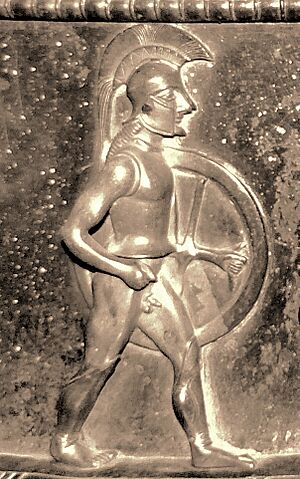
The many imported items from the Mediterranean show that the people at Vix traded widely. Greek or Etruscan traders might have brought these items to Vix. The huge amount of luxury goods found at Vix is very special for Europe during the La Tène period.
Some experts think the krater, which is the largest known Greek bronze pot, was a very important gift. It might have been part of a trade deal where wine from the Mediterranean was exchanged for raw materials from northern Europe.
Where to See It
You can see a reconstruction of the grave and the original items at the museum in Châtillon-sur-Seine.
Other Burial Mounds
Besides the "Lady of Vix" grave (called mound I), there are five other large burial mounds in the area. Three of them have been dug up.
- Mound II was 33 meters (108 feet) wide. Its central room held an urn with burned human remains. Items found with it date to about 850 BC.
- The mound of La Butte is probably from the mid-500s BC. Like the famous Vix grave, it held a woman placed in a cart or chariot. She was buried with two iron axes and a gold bracelet.
- A third mound, at La Garenne, was destroyed in 1846. It also contained a cart and an Etruscan bronze bowl with four griffin or lioness handles. We don't know if it contained human remains.
Stone Statues
In 1994, pieces of two stone statues were found in a small area. One was a warrior, and the other was a woman.
Why Vix Matters
In this area, and across Central and Western Europe, the early Iron Age brought big changes. People started to live in more organized groups with different social levels. It seems that at the top of these groups were very important people. They became powerful because of the growing trade in iron ore and iron. We don't know if they were "princesses" or "princes" in the modern sense, or if they were rich traders. This is still something experts discuss.
We see proof of these changes in the rich graves from this time. These graves are very different from the simpler burials that came before. We also see changes in how settlements were built. Before, there were large open settlements. Later, smaller, strong settlements developed, often in important places. These are sometimes called "princely sites." Many such sites are known from the Late Hallstatt and Early La Tène periods in Europe. Examples include the burials at Hochdorf and Magdalenenberg, and the settlements at Heuneburg and Glauberg.
Iron ore was much easier to find than the materials needed for bronze, like copper and especially tin. So, being successful no longer just meant having access to raw materials. It also depended on trade routes and how goods were moved. The extra wealth in well-located places was used to build impressive settlements and defenses. It was also spent on jewelry and expensive imported luxury items. This kind of wealth was not possible before.
Images for kids
See also
- Hochdorf Chieftain's Grave
- Graves of Sainte-Colombe-sur-Seine
- Lavau Grave
- Heuneburg
- Glauberg
- Hohenasperg
- Ipf (mountain)
- Burgstallkogel
- Alte Burg
- Vorstengraf (Oss)
- Grächwil
- Grafenbühl grave
- Reinheim grave
- Princely Grave of Rodenbach
- Mitterkirchen Keltendorf
- Lingons
- Oppidum of Manching


